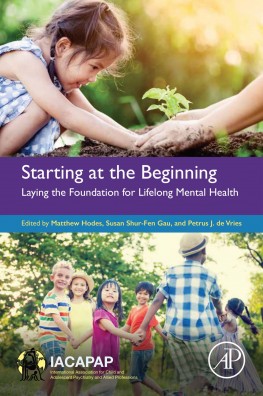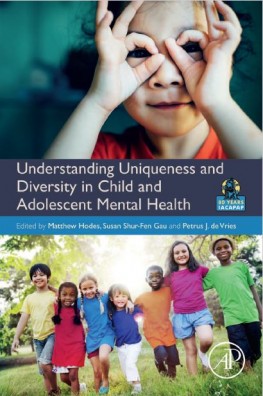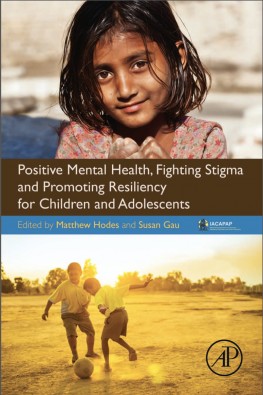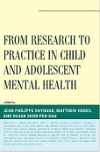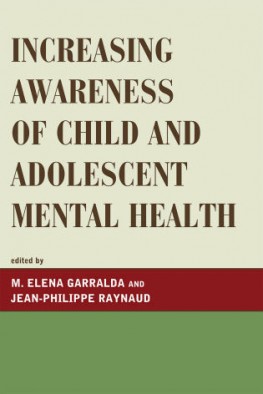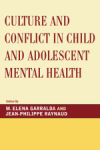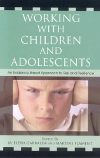Monographs
IACAPAP supports the publication of Monographs that are released to coincide with the biennial congresses. The Monographs address congress themes, regional issues and innovations of global significance in child and adolescent mental health. The current series is available here, starting with the Calgary 2016 Monograph “Positive Mental Health, Fighting Stigma and Promoting Resiliency for Children and Adolescents” and now the Dubai 2022 Monograph “Shaping the Future of Child and Adolescent Mental Health - Towards Technological Advances and Service Innovations”.
The books from the previous series are listed here. They were released for the Melbourne 2006, Istanbul 2008, Beijing 2010, Paris 2012 and Durban 2014 Congresses and can be obtained from the publisher at rowman.com.
Shaping the Future of Child and Adolescent Mental Health - Towards Technological Advances and Service Innovations (2022)
Edited by Matthew Hodes and Petrus J. de Vries
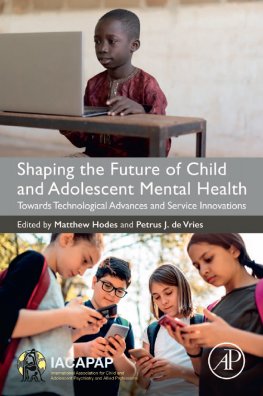
Shaping the Future of Child and Adolescent Mental Health - Towards Technological Advances and Service Innovations was published to coincide with the 25th International Association for Child and Adolescent Psychiatry and Allied Professions (IACAPAP) Congress that took place in Dubai from 5-9 December 2022. The book includes three overarching themes. The first is the impact of the internet and digital technologies on the mental health and wellbeing of children and adolescents, including computerised therapies, and the fundamental role of technologies to advance knowledge in the field. The second theme harnesses the expansion of knowledge on psychiatric disorders and their treatment for children and adolescents, exemplified by chapters on different kinds of adversity in child and adolescent mental health and a chapter on precision therapeutics. Given the location of the IACAPAP Congress, the third theme focuses on research and training in child and adolescent mental health in the Eastern Mediterranean Region.
Chapters provide insights into a broad range of contemporary technology and service innovation related topics in child and adolescent mental health (CAMH). These include growing up in the digital age (Theron et al., chapter 1), cyberbullying (Pascual-Sanchez and Nicholls, chapter 2), clinical applications of big data (Wickersham and Downs, chapter 3), machine learning (Tiffin and Paton, chapter 4), computerized cognitive behavioural therapy (Stallard, chapter 9) and technology-enhanced learning (Stylianakis et al., chapter 11). New insights on adversity and on understanding of psychopathology and therapies are addressed in chapters on COVID-19 (Newlove-Delgado et al., chapter 5), on the consequences of psychological trauma (Lewis and Danese, chapter 6), autoimmune encephalitis (Schieveld et al, chapter 7), and precision therapeutics in depression (Aitken et al., chapter 8).
Acknowledging the global challenge of child and adolescent psychiatry and mental health, readers will find an emphasis on contextual challenges in the field, including innovations for scaling up of mental health intervention in low- and middle-income countries (Waqas and Rahman, chapter 10), on CAMH research in the Eastern Mediterranean Region (Maalouf et al., chapter 12) and on training in child and adolescent psychiatry in the Gulf region (Albanna et al., chapter 13).
Key Features:
• Emphasizes digital influences and applications in child and adolescent mental health research, psychiatric treatments and training
• Highlights children and adolescents in adversity, including COVID-19 and psychological trauma
• Appraises new approaches to understanding selected psychiatric disorders in children and adolescents
• Addresses the research in child and adolescent psychiatry and mental health across the Eastern Mediterranean Region and training in the Gulf Region
Starting at the Beginning: Laying the Foundation for Lifelong Mental Health (2020)
Edited by Matthew Hodes, Susan Shur-Fen Gau, and Petrus J. de Vries. (Academic Press)
“Starting at the Beginning: Laying the Foundation for Lifelong Mental Health” is published to coincide with a series of web-based events that replace the 24th International Association for Child and Adolescent Psychiatry and Allied Professions (IACAPAP) Congress in Singapore.
This book examines epidemiological and cultural perspectives in Child and Adolescent Mental Health (CAMH), risk, prevention, and intervention opportunities in developmental neuropsychiatry, new perspectives on problems and disorders, and Asian Perspectives in CAMH policy and services. It addresses the ways in which interventions and mental health services can be developed and shaped to address the individual differences amongst children in different contexts.
Specific chapters address national epidemiological surveys of child and adolescent mental health including the Taiwanese survey (Gau and Chen, chapter 1), and cultural psychiatry as the basic science addressing mental health and disparities (Guerrero and Andrade, chapter 2). Chapters on developmental neuropsychiatry address consequences of chemical exposure amongst children in South Korea (Jang et al, chapter 3), early life determinants of health and breaking the cycle of disadvantage (Eapen et al, chapter 4), and implementation of early interventions for autism spectrum disorders in resource limited settings, exemplified by South Africa ( Schlebush et al, chapter 5). The third section on problems and disorders provide a developmental model of hikikomoro (Kato, chapter 6), a chapter on gaming disorder (King and Delfabbro, chapter 7), and chapters on common challenges and pitfalls in treating paediatric OCD ( Krebs et al , chapter 8), and developmental perspectives and treatment implications for ADHD ( Coghill and Seth, chapter 9). The final section addresses child-centric mental health policies (Fung and Poremski, chapter 10), policy and practice of CAMH in China ( Zheng, chapter 11), and CAMH needs, services and gap in East and South East Asia and Pacific (Hirota, et al, chapter 12).
The chapters are written by internationally recognised experts, in an accessible style, and illustrated with many figures and tables.
Understanding Uniqueness and Diversity in Child and Adolescent Mental Health
Editors: Matthew Hodes, Susan S-F Gau, Petrus J de Vries. Elsevier, Academic Press. 2018
The 2018 Monograph has been prepared for the 23rd IACAPAP World Congress held in Prague, Czech Republic, in July, 2018. The theme of the congress, “Understanding Diversity and Uniqueness,” has influenced the title of this Monograph.
Understanding Uniqueness and Diversity in Child and Adolescent Mental Health examines the determinants of individual differences in children and young people, and the origins of maladjustment and psychiatric disorders. It addresses the ways in which interventions and mental health services can be developed and shaped to address the individual differences amongst children. Additional topics include the influence of economic adversities and gender differences on child development and the life course, as well as the range of risk and protective factors associated with the onset and persistence of problems.
Chapters dive deeper into antisocial behaviour (Acquaviva et al), bipolar disorder (Goetz et al), tics and Tourette’s (Eapen et al), anxiety disorders (Koydemir & Essau), medically unexplained symptoms (Rask et al), developmental aspects of infancy and adversities (Hunt & Tomlinson, Berg et al) , gender dysphoria (Harper et al) and the needs of refugee children in Europe (Fegert et al). One section addresses the benefit of targeting interventions, as illustrated by a chapter on pharmacogenomics (Malik et al), and another on the ways in which services can be adapted for specific environments by using telemedicine (Malhotra & Shah). The final section addresses European themes on the development and practice of child and adolescent mental health in Central Europe (Remschmidt et al) and training across the continent (Jacobs et al).
Key Features
- Emphasizes social and environmental influences
- Focuses on early developmental and infancy processes
- Covers a range of illustrative psychiatric disorders and problems
- Addresses the training of child and adolescent psychiatrists across Europe
- Works toward the goal of producing a mental health workforce with internationally recognized competencies
POSITIVE MENTAL HEALTH, FIGHTING STIGMA AND PROMOTING RESILIENCY FOR CHILDREN AND ADOLESCENTS
Edited by Matthew Hodes Susan Gau
Published September 2016
“Traditionally the monographs had followed the themes of the numerous IACAPAP congresses, and their contents provided summaries of disorders and treatments in the child and adolescent mental health field. With the growth of the IACAPAP website and textbook, the monograph has been focused to address congress themes, regional or social issues, new topics, and selective reviews in child and adolescent mental health treatments and other innovations. This monograph addresses the themes of the 2016 Calgary Congress entitled “Fighting Stigma, Promoting Resiliency and Positive Mental Health,” as well as including evidence-based reviews of selective treatment areas. A further change for the monograph, in keeping with IACAPAP’s move to more Internet-based open access to materials, is that for the first time it will become available online, one year after the congress”—M. Hodes & S. Shur-Fen Gau
From Research to Practice in Child and Adolescent Mental Health
Edited by Jean-Philippe Raynaud; Matthew Hodes and Susan Shur-Fen Gau
Published May 2014
From Research to Practice in Child and Adolescent Mental Health has been shaped to reflect the mental health needs of children and adolescents in low and middle income countries of the world. It also includes chapters on topics based on research and practice in high income countries which may have lessons and implications universally.
“The world population balance is shifting. Rich, developed countries’ inhabitants are becoming older while people in low and middle income countries are becoming younger, so much so that a large proportion of the world’s youth now lives in these countries. Another shift is also taking place in youth-rich countries: their leaders are increasingly concerned about improving the mental health of their people and realize the need to train more and better professionals to deal with these problems. This book is a key source of information for policy and practice that would be useful for professionals in training and leaders when addressing these issues.” – Joseph M. Rey, PhD, University of Sydney
Brain, Mind and Developmental Psychopathology in Childhood
Edited by Elena Garralda and Jean-Philippe Raynaud

The 2012 Paris Congress Book has empirical chapters on biological and psychological influences on developmental psychopathology in childhood, clinical updates with a focus on the biological underpinnings of individual child neuropsychiatric disorders, and a chapter on how to integrate biological and psychological therapies in child mental health as well as on advocacy for child mental health.
“Brain, Mind, and Developmental Psychopathology in Childhood, a number of the most distinguished international researchers in their areas share current ideas about and future perspectives on how to understand the biological and psychosocial background for psychopathologic conditions in developing children. It underscores the need for both a holistic and multidisciplinary approach. The book considers the future of the field, including topics such as a hope for a more detailed knowledge of how the brain works, similarities and differences between the female and the male brain, and how the genes interact with the environment when the brain is shaped during fetal life and during the long period of brain maturation in the first 25 years of life. An excellent book-highly recommended.” – Per-Anders Rydelius, Karolinska Institutet, Stockholm, Sweden
The IACAPAP Book in 2010 – Increasing Awareness of Child and Adolescent Mental Health
Edited by M. Elena Garralda and Jean-Philippe Raynaud
“This book provides a rich, stimulating, and up-to-date account of the state of child mental health throughout the world. I can thoroughly recommend it to all child and adolescent mental health professionals who wish to broaden their horizons and gain new perspectives on their own practice.” — Philip Graham, Emeritus Professor of Child Psychiatry, Institute of Child Health, London
Culture and Conflict in Child and Adolescent Mental Health
Edited by M. Elena Garralda and Jean-Philippe Raynaud
“This volume of papers from the IACAPAP conference give the reader a flavour of critical, provocative and challenging work going on globally in the field of child and adolescent mental health. It is a fascinating account of the research, the setting up of programs, and the attempts to train workers in cultural areas far outside our usual zones of comfort.” — Rudy Oldeschulte, Metaphysical Online Reviews, Aug 25, 2009
Working with Children and Adolescents: An Evidence-Based Approach to Risk and Resilience
Edited by Elena Garralda and Martine Flament
“The entire volume is a remarkable engaging, readable, and comprehensive compilation of selected topics of the recent advances in understanding risk and resilience factors in the field of child mental health. It is well written and well edited….a scholarly yet readable, interesting, and accessible summary of our current science and clinical expertise in the field of risk and resilience.” — February 2008, The Journal of Clinical Psychiatry
The Child in his Family Series (1970 – 1994) (no longer published)
| Vol | Year | Title | Publisher | Editors |
|---|---|---|---|---|
| 1 | 1970 1970 | The child in his family L’enfant dans la famille | WileyMasson | E.J. Anthony & C. Koupernik |
| 2 | 1973 1974 | The impact of disease and death L’enfant devant la maladie et la mort | Wiley | idem |
| 3 | 1974 1980 | Children at psychiatric risk L’enfant et haute risque psychiatrique | WileyPUF | E.J. Anthony, C. Chiland & C. Koupernik |
| 4 | 1978 1980 | Vulnerable children L’enfant vulnerable | WileyPUF | idem |
| 5 | 1978 1984 | Children and their parents in a changing world Parents et enfants dans un monde en chamgement | Wiley PUF | E.J. Anthony & C. Chiland |
| 6 | 1982 1985 | Preventive child psychiatry in an age of transitions Prevention en psychiatrie de l’enfant dans un temps de transition | Wiley PUF | idem |
| 7 | 1982 1985 | Children in turmoil: tomorrow’s parents Enfants dans la tourmente: Parents de demain | Wiley PUF | idem |
| 8 | 1986 1992 | Perilous development: child raising and identity formation under stress Le developpement en peril | Wiley PUF | idem |
| 9 | 1992 1990 | New approaches to infant, child, adolescent and family mental health Nouvelle approches de la sante mentale de la naissance a l’adolescence pour l’enfant et sa famille | Yale University PressPUF | C. Chiland & J.G. Young |
| 10 | 1990 1990 | Why children reject school: view from seven countries Le refus de l’ecole: Un apercu transculturel | Yale University PressPUF | idem |
| 11 | 1994 1998 | Children and Violence Les enfants et la violence | Jason Aroson IncPUF | |
The Leadership Series (1998 – 2004) (no longer published)
| Vol | Year | Title | Publisher | Editors |
|---|---|---|---|---|
| 12 | 1998 | Designing mental health services and systems for children and adolescents: A shrewd investment | Brunner/Mezel | J.G. Young & P. Ferrari |
| 13 | 2002 | Brain, culture and development | MacMillan | J.G. Young, P. Ferrari, S. Malhotra, S.Tyano & E. Caffo |
| 14 | 2004 | Facilitating pathways: Care, treatment and prevention in child and adolescent mental health | Springer | H. Remschmidt, M. Belfer & I. Goodyer |
The Working with Children & Adolescents Series (2006 onwards)
| Vol | Year | Title | Pubisher | Editors |
|---|---|---|---|---|
| 15 | 2006 | Working with children and adolescents: An evidenced-based approach to risk & resilience | Jason Aronson | ME Garralda & M. Flament |
| 16 | 2008 | Culture and conflict and child and adolescent mental health | Jason Aronson | ME Garralda & JP Reynaud |
| 17 | 2010 | Increasing awareness of child and adolescent mental health | Jason Aronson | ME Garralda & JP Reynaud |


